After my post yesterday about Fellow Patheos Blogger Pastor Mark Driscoll’s citation issues, reader and college prof Aaron New sent along an example of another problem in Driscoll’s most recent Patheos blog post.
The post, “What is the Bible? Answering 4 Common Questions About the Bible: Part 1,” largely comes from his book with Gerry Breshears, Doctrine: What Christians Should Believe. To his credit, Driscoll alerted readers to that fact at the end of the post.
More troubling is the lack of quotes and citation for the following section. From yesterday’s post:
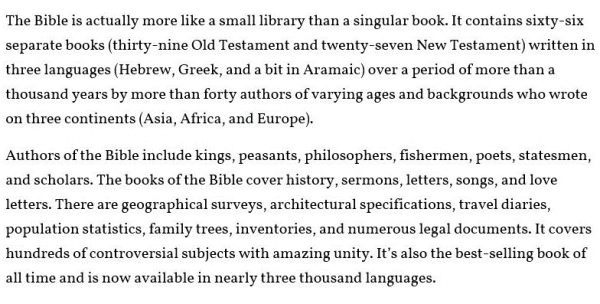
Now take a look at a book first published in 1997 (2nd edition in 2009) written by Aubrey Malphurs and titled, Ministry Nuts and Bolts: What They Don’t Teach Pastors in Seminary. On page 190 of that book, Malphurs provides the following description of the Bible. The portion of interest begins in the third full sentence of the paragraph below.
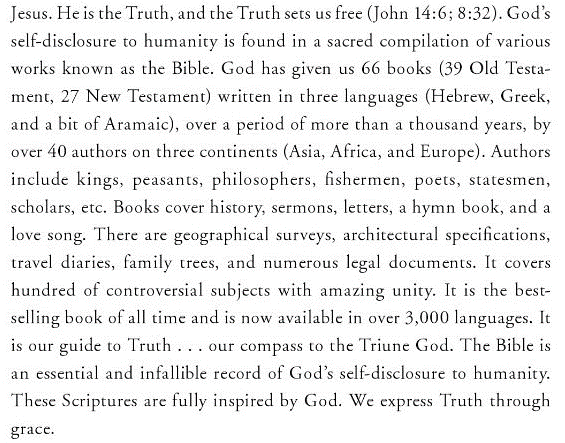
The passages are nearly identical. Even though the facts are commonly known, the order, wording, and presentation of those facts are nearly the same in both places. The Driscoll and Breshears book has a 2010 copyright date; Malphurs’ book shows two copyright dates, 1997 and 2009. Most of the Malphurs’ material is also in the Doctrine book, but a couple of the copied sentences are only in the Patheos blog post.
Readers, I will leave it to you to draw your own conclusions. I report, you decide. Just to make it clear, below is the Patheos blog post passage with the identical material underlined. What is not underlined is only slightly reworded. Only a very few additional words were added.
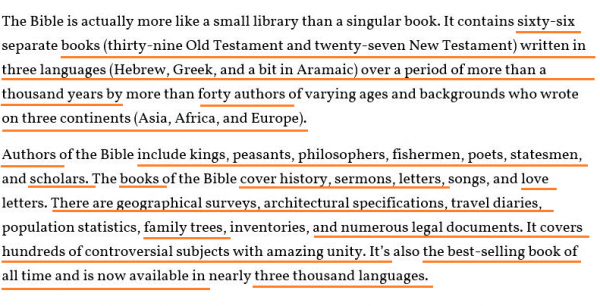
There may be more instances like this. I only examined two paragraphs in the Patheos blog. I think some explanation should be forthcoming for why the water that was under the bridge is now gushing forth in this new season.
Tag: The Trinity Church
A Citation Error by Fellow Blogger Mark Driscoll Is a Blast from the Past

After reading the most recent post by my Fellow Patheos Blogger Pastor Mark Driscoll™ last night, a frequent reader of my blog informed me that the new post recycles lots of material from Driscoll’s book on doctrine. Indeed, there are several paragraphs in his Patheos post on evil in Las Vegas which first appeared in his book with Gerry Breshears titled Doctrine: What Christians Should Believe. For instance, Driscoll wrote in his post:
The Bible uses a constellation of images to explain sin as everything from rebellion to folly, self-abuse, madness, treason, death, hatred, spiritual adultery, missing the mark, wandering from the path, idolatry, insanity, irrationality, pride, selfishness, blindness, deafness, a hard heart, a stiff neck, delusion, unreasonableness, and self-worship. Sin and evil are not rational or reasonable.
In his Doctrine book, he introduces a section on sin with the same paragraph:
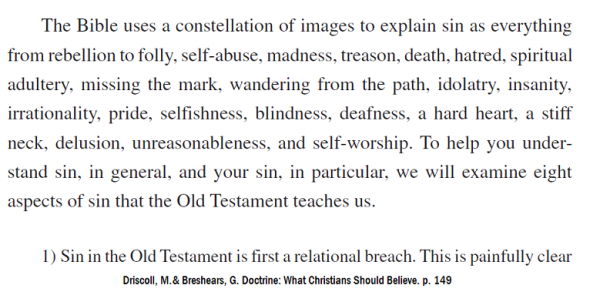
To Recycle or Not?
Recycling previously published material without citation is somewhat controversial in the world of writers. Journalist Jonah Lehrer had his career sidetracked over it. I discovered lots of it in Fellow Patheos Blogger Mark Driscoll’s™ books. However, in this case, I doubt many people will care that he is recycling previously published material at his new blog.
On the other hand, his co-author might care. Unless Gerry Breshears was not really very involved or just lent his name, the material claimed now by Driscoll might have been written by Breshears. Having a co-author is one reason why authors should cite the original source for recycled material.
Deja Vu All Over Again*
However, the same reader alerted me to something else I hadn’t seen before. It appears I found another “citation error” (some would call it plagiarism) in Doctrine (see this image for other such citation errors). On pages 149-150 of the 2010 book (see the page image here), Driscoll and Breshears wrote:
To help you understand sin, in general, and your sin, in particular, we will examine eight aspects of sin that the Old Testament teaches us.
1) Sin in the Old Testament is first a relational breach. This is painfully clear in Genesis 2–3 where, because of their sin, our first parents are separated from God and one another; they hide from God and one another, fear God, blame one another, and seek to cover their sin and shame while living their life apart from God.
2) Sin in the Old Testament is a social matter because shalom has been vandalized. This is evidenced by the litany of murder, perversion, drunkenness, the continual evil that precipitated the flood, and human attempts at an Edenic-like society without any regard for God that spring forth in Genesis 4–11.
3) Sin in the Old Testament is a covenantal rebellion against God and his authority. This is witnessed perhaps most clearly in Exodus 32 to 34, where following God’s liberation of his people, they dishonor, disregard, and disobey him by worshiping idols while God is giving them the Ten Commandments through their leader Moses.
4) Sin in the Old Testament is a legal transgression that results in guilt that necessitates punishment. One clear example is found in Deuteronomy 32, where in worshipful song Moses recollects some of the most treasonous behavior of God’s people and the price that had to be paid for justice to be maintained.
5) Sin in the Old Testament results in ritual uncleanness, pollution, and filth, marked by the use of words such as “filth,” “defiled,” “unclean,” and “whore.”18 Importantly, this defilement happens both to sinners and victims; we defile ourselves by our own sin and are defiled by others when they sin against us.
6) Sin in the Old Testament includes emotional pain such as shame and disgrace.19 This is first seen in Genesis 3, where our first parents sin and then hide in shame and disgrace, whereas prior to their sin they “were not ashamed.”20
7) Sin in the Old Testament is spoken of in historical terms as an accumulating burden whereby sin is piled up from one generation to the next.21 In this way, sin only worsens over time as people invent new ways to do evil more effectively.
8) Sin in the Old Testament is spoken of with the finality of death.22 Sin is deadly, and ends only in death. This is because when we sin and prefer created things to our creator God, we stop ruling over creation and are ruled by it so that in the end we lose and the dust wins.23
(The footnotes go to Bible verses not human authors as you can see in the page image)
Now read the same eight aspects written by Christopher Wright in a 2008 book about the atonement (Scroll down to Chapter Four “Atonement in the Old Testament” and read the first four pages of that chapter – See the page images for the relevant parts of Wright’s chapter here as well: one, two)
The eight aspects of sin described by Wright ended up in Driscoll’s book without citation. The explanations were gently reworded but reflect the same classification and meaning as Wright’s two years earlier. Some of the same key words, phrases, and Bible passages also remain used as Wright did, e.g., Adam and Eve, shalom, Exodus 32-34, shame and disgrace, accumulating burden, etc. (See also this side by side comparison.)
It was as if I was transported back to 2014.
*”Deja vu all over again” is often attributed to Yogi Berra.
Mark Driscoll and K.P. Yohannan: Welcome to Patheos!
Allow me to be among the first to welcome Mark Driscoll and K.P. Yohannan to Patheos!
Mark Driscoll announced his new blog today via the Patheos Evangelical Facebook page. Watch:
Judging from a couple of tweets I have seen (for instance here), he must have announced on Twitter too. I wouldn’t know it since he blocked me a long time ago after I wrote a few articles about him and his former church.

We are now practically neighbors!
K.P. Yohannan isn’t as well known as Driscoll in the U.S. but he is the Most Reverend Eminence in India.
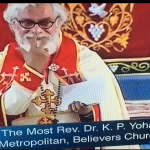 It will be interesting to see if Yohannan blogs about his organization’s legal troubles and trial preparations. It will give readers a couple of different perspectives to read about it there and here.
It will be interesting to see if Yohannan blogs about his organization’s legal troubles and trial preparations. It will give readers a couple of different perspectives to read about it there and here.
Having Yohannan and Driscoll in the family makes me wonder when David Barton and Eric Metaxas plan to join up.
Kumbaya!
Mark Driscoll’s Recycling Ministry
This came in the mail:
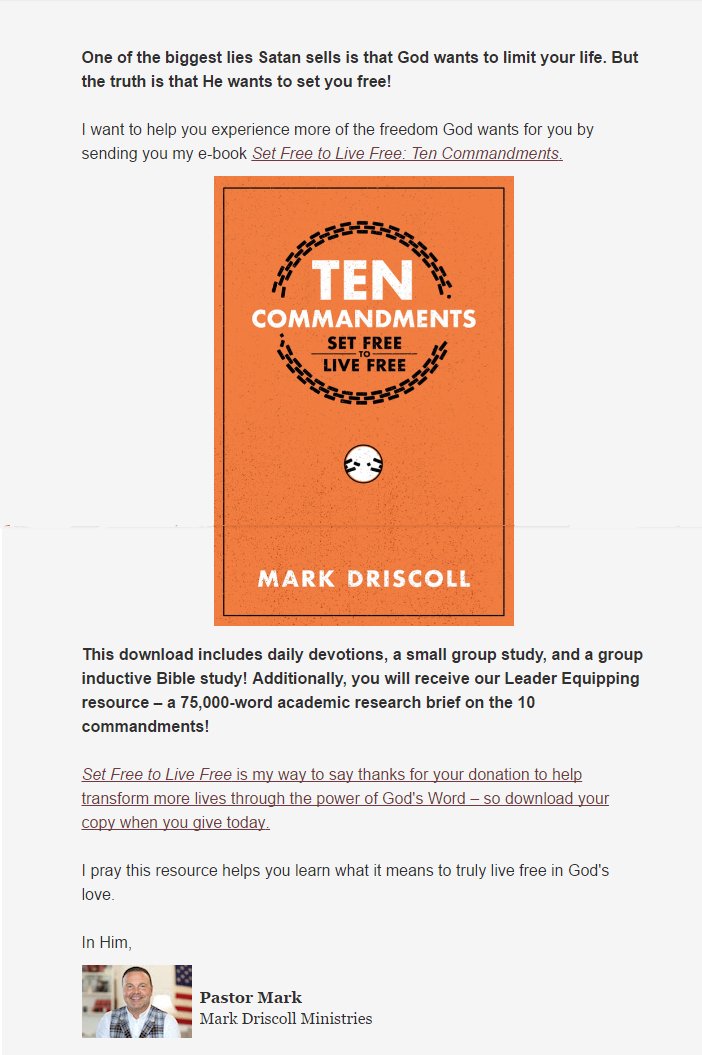
This is a recycled version of the Set Free to Live Free Campaign financed by Mars Hill Church in 2013. Naturally, Driscoll kept his intellectual property but apparently he got all of the other materials produced by the church (study guide written by church staff) and purchased by the church from Docent Research (the 75,000 word academic research brief) as well. Note that the beneficiary of these donations is Mark Driscoll Ministries and not The Trinity Church.
Hey, recycling does lead to more green.
For Those Interested in Mars Hill Church History, Wenatchee the Hatchet Has Organized Some Links. A Former Elder's Wife Speaks Out
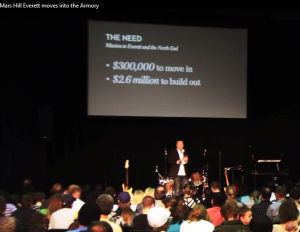 For Mars Hill history buffs, Wenatchee the Hatchet has done a service for you. Go check out his post with links tagged and organized topically.
For Mars Hill history buffs, Wenatchee the Hatchet has done a service for you. Go check out his post with links tagged and organized topically.
Also, wife of a former elder Jen Smidt has spoken out about her experiences at Mars Hill. According to Jen, she once said something Sutton Turner didn’t like and the next day Turner rebuked her husband for it.
WtH has a lengthy account and analysis which I won’t try to compete with.
It occurred to me recently that a final accounting of Mars Hill was never made public. I assume the assets were sold and divided up between the legacy churches but no final reporting ever became public. Secrecy persisted until the end.
For all of my posts on Mars Hill Church and The Trinity Church see below:
Mars Hill Church
The Trinity Church (the post-Mars Hill church Mark Driscoll started in Phoenix)